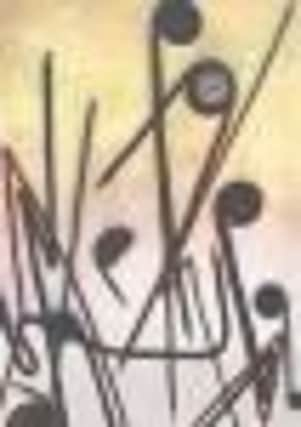Slow Marathon all about the art of walking


She’d broken up with a boyfriend, was worried and felt she needed to clear her head. She went for a walk. “Ten miles later, along the banks of the Thames, I had walked the problem away. It was a revelation.”
Nowadays, as director of an innovative organisation that has brought contemporary art into the very fabric of a small Aberdeenshire town, walking has become so central to Zeiske’s life and work that she uses it as a management tool, a way of holding meetings and discussions, and, at times, a personal respite. “If I’m stressed I just need to think that when Saturday comes I will go out for a walk,” she laughs. “It probably saves a fortune on counselling.”
Advertisement
Hide AdAdvertisement
Hide AdBut Zeiske has also cottoned on to the fact that walking has a long cultural pedigree, both as an aid to art and as art in itself. This spring, Deveron Arts will work with Ethiopian artist Mihret Kebede to bring the benefits of walking to local citizens, in lots of events culminating on 17 March in Slow Marathon, a 26-mile walk in the local scenery.
Kebede, who is from Addis Ababa, says she loved the idea of walking all the way from her home to Huntly, but visa regulations and logistics made it impractical. “It’s impossible because of the barriers, the borders, the desert,” she explains. Instead she is inviting walkers to join her in clocking up the 9,000km distance.
She reckons she needs 225 marathons to do so and those who can’t make it to Huntly on the day can log their own mileage from home. Participants so far include the Berlin-based artist Olafur Eliasson and the eminent American artist and theorist Lucy Lippard.
You simply use the Deveron Arts website to take part, says Zeiske: “You can, for example, just decide today you don’t want to get on the metro as usual, walk the three miles and then log them with us.”
In Addis Ababa, the capital of a country that is a world leader in distance running, 225 Ethiopians, including the former world record holder Haile Gebrselassie, will try to walk far enough to “bring Kebede home again”.
In a gesture intended to link the two communities, participants in the two countries will swap shoelaces. “People have to communicate,” says Kebede. “I’m trying to create a link between Scotland and Ethiopia.” Gebrselassie’s shoelaces are apparently already on their way.
The two communities are strikingly different in many ways, not least in the fact that Ethiopians are far more active walkers than Scots, but size is one of the more striking factors. Achieving 225 marathons in a town of 4,000 people is a harder task than in a city of six million.
Advertisement
Hide AdAdvertisement
Hide AdKebede is not alone in being a walking artist. Eminent figures such as Richard Long and Hamish Fulton have long used the landscape and walking itself in their work. Fulton spent time in Huntly and 21 days alone in the Cairngorms with only a rucksack at Zeiske’s invitation in 2010. Rebecca Solnit’s book Wanderlust has become a bible amongst artists and thinkers of all stripes who believe that walking is not only a fundamental human need but a catalyst for creativity and change.
The writer Linda Cracknell is one of them and she is taking advantage of a bit of winter sunshine on a visit to Edinburgh and walking to Portobello via Arthur’s Seat when I catch up with her. Cracknell uses walking both as subject matter and a practical tool in her writing. In May, she will hold a weekend workshop, Words In The Landscape, using walking at the writer’s retreat Moniack Mhor near Beauly.
“There is something that walking does that helps creativity,” she explains. “The inner journey is often as vivid as the external.” Walking, she says, can help writers get “unstuck”, and can “unlock memory”.
For Cracknell, walking is not about isolation, it is a social activity. “The revelation for me came in 2004. A friend asked me to walk with her the route that her father had taken as a member of the Norwegian resistance walking out of Norway to Sweden.
“Our journey was very rich in people, and even in lonely places there had been people who had helped him on his way. People came to walk with us including the children and grandchildren of those who had helped him. I realised that, for me, walking was about human resonances, not about getting away.”
Charles Dickens used walking as a means of gleaning information from Victorian street life. Cracknell cites many writers for whom walking is a fundamental activity. “Wordsworth couldn’t write without walking, and Hardy is very important to me – those awful journeys where somebody walks 25 miles in the rain with a letter which ends up lost under the door mat.”
Like Cracknell, Zeiske believes that walking can be both a stimulus to art and a practical tool. Recognising the time pressures that many people experience and the difficulty of getting exercise, she devised the Walking Lunch, where she holds meetings on the hoof. “They take an hour, we agree the agenda beforehand, I bring the sandwiches and write the minutes.” She has arranged walking tours of artists’ studios and last year walked the border between Scotland and England to highlight the problems artists are experiencing under new visa regulations.
Advertisement
Hide AdAdvertisement
Hide AdKebede too is familiar with visa red tape. She’s hoping that walking will be a way to bring hundreds of Scots and Ethiopians together without the hassles of border crossings.
Sign up to take part in the Slow Marathon or to register to walk a cumulative marathon by email: [email protected], by text 07507 393590 or in person at the Deveron Arts shop on Bogie Street, Huntly